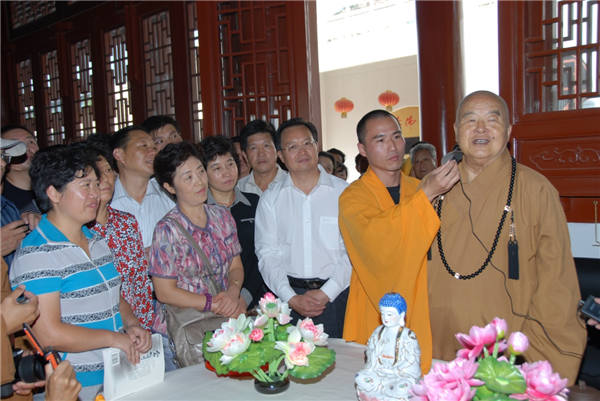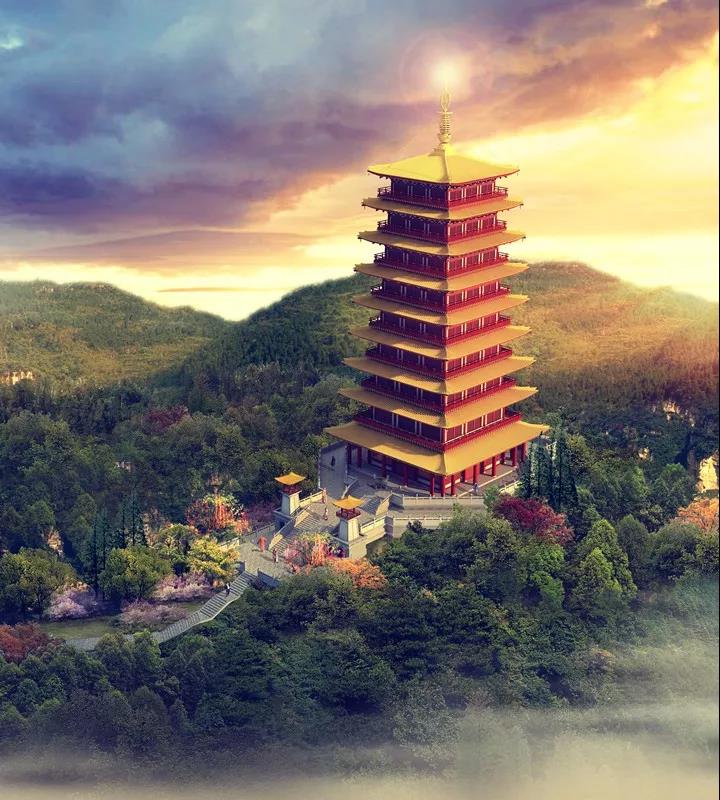MENU



 0518-88856008
0518-88856008 


 0518-88856008
0518-88856008 


 It is located on the east side of shanxi peak in dayi. The name of the temple means that the eminent buddhist monk of eastern jin dynasty said, "the saying of sheng gong, the stubborn stone nods", which means that Buddha pushes the cause and results, and persuades people to do good and transcend living beings. According to the local records of qing dynasty, "in the second year of emperor qing's reign (1313), sanzang in kaishan was rebuilt in the 10th year of the reign of emperor hongwu in the Ming dynasty. In the 24th year of the reign of emperor hongwu, sanzang was restored to the da-ci-si temple. It is said that the young Yin kong monk, in anhui jiuhuashan guangxue inside and outside classic, later because of day and night for "dazhi" annotated and accumulated strain into a disease, everywhere seek medical treatment, all can not be cured. One day, when he was wandering in the mountains of tai yi, he was sitting under an old cypress in the early morning. Suddenly, he saw a big Buddha standing in the air. Imku was meditating in this gatha, and suddenly he felt that the pain was getting better. He went through all kinds of hardships and turned to alchemy. After more than ten years, he managed to raise silver liang to build the temple. In the second year of emperor qing's reign, he built the taishan stone buddhist temple. The stone Buddha in front of the ancient temple is the source of Lao longjian. Old stone buddhist temple, into a courtyard - style. Gate southeast, three 2 - story building. After hill door 3 daxiong treasure hall, treasure hall has 3 east hip hall, 3 west hip hall. There is a large stone censer in the courtyard. Vermilion walls inside, far away can be expected to see the three canopies canopies construction of the grand hall, magnificent. Up the steps along the old dragon gorge, into the gate, the two sides of the four king kong, chuzhong maitreya ushered in the smile. Tall stone censer in the courtyard, incense curl. The two sides are arranged in an orderly arrangement of more than 10 hip rooms. The statue of sakyamuni is enshrined in the hall, carved from hard marble and alum. On both sides of the altar of Buddha a word to open 18 luohan, from the rock carved tai yi. At the end of qing dynasty and the beginning of the republic, there was a Taoist monk named guo from Shanxi Province, whose accent was "ge". Hence, he was called Lao dao. He came to da-yi mountain for avoiding misfortune.
It is located on the east side of shanxi peak in dayi. The name of the temple means that the eminent buddhist monk of eastern jin dynasty said, "the saying of sheng gong, the stubborn stone nods", which means that Buddha pushes the cause and results, and persuades people to do good and transcend living beings. According to the local records of qing dynasty, "in the second year of emperor qing's reign (1313), sanzang in kaishan was rebuilt in the 10th year of the reign of emperor hongwu in the Ming dynasty. In the 24th year of the reign of emperor hongwu, sanzang was restored to the da-ci-si temple. It is said that the young Yin kong monk, in anhui jiuhuashan guangxue inside and outside classic, later because of day and night for "dazhi" annotated and accumulated strain into a disease, everywhere seek medical treatment, all can not be cured. One day, when he was wandering in the mountains of tai yi, he was sitting under an old cypress in the early morning. Suddenly, he saw a big Buddha standing in the air. Imku was meditating in this gatha, and suddenly he felt that the pain was getting better. He went through all kinds of hardships and turned to alchemy. After more than ten years, he managed to raise silver liang to build the temple. In the second year of emperor qing's reign, he built the taishan stone buddhist temple. The stone Buddha in front of the ancient temple is the source of Lao longjian. Old stone buddhist temple, into a courtyard - style. Gate southeast, three 2 - story building. After hill door 3 daxiong treasure hall, treasure hall has 3 east hip hall, 3 west hip hall. There is a large stone censer in the courtyard. Vermilion walls inside, far away can be expected to see the three canopies canopies construction of the grand hall, magnificent. Up the steps along the old dragon gorge, into the gate, the two sides of the four king kong, chuzhong maitreya ushered in the smile. Tall stone censer in the courtyard, incense curl. The two sides are arranged in an orderly arrangement of more than 10 hip rooms. The statue of sakyamuni is enshrined in the hall, carved from hard marble and alum. On both sides of the altar of Buddha a word to open 18 luohan, from the rock carved tai yi. At the end of qing dynasty and the beginning of the republic, there was a Taoist monk named guo from Shanxi Province, whose accent was "ge". Hence, he was called Lao dao. He came to da-yi mountain for avoiding misfortune.
 Located in the south gate of Dayi Mountain, within the South Gate Square of Shifo Temple. The Yishan Buddha is a statue of Sakyamuni Buddha. It was built on August 28, 2007, and the dome was opened on May 12, 2008 and August 28, 2009. The Buddha statue is made of wrought copper and uses more than 70 tons of copper. The height of the Buddha statue is 33 meters (meaning 33 days), the altitude is 66 meters high; the lotus seat is 6 meters high, the height of the seat is 5 meters, the base platform is 6 meters high, and the bottom line of the platform is 16 meters above sea level. Liu Weishun, the Liuliu Dashun, symbolizes auspiciousness, and is consistent with Buddhism’s “six degrees and six sums”. The Yishan Buddha is the highest sitting Buddha statue in Asia today. The design creator is Chen Jiebin, a famous young sculptor who graduated from the China Academy of Art. The Yishan Buddha is based on the Buddha of Sakyamuni. It is conceived with reference to Buddha statues such as the Burma Buddha, the Hong Kong Temple of Heaven and the ancient Chinese ancient Buddha statues. It reflects solemnity, compassion, condescending, overlooking sentient beings, right thumb, index finger, interlocking, meaning Guan Guan, Ding Hui, Quan Shi, Compassion, etc., the folks call the lotus finger. The Buddha's feet are tied to the scorpion, indicating the Buddha's phasing. The Buddha's eyelids, eyebrows, and nose and mouth are characterized by the charity and peace of the Buddha. The five senses are full of heaven, the square is round, the ears are big, the nose is straight, and the ears are two shoulders. It is the most favorite and appreciated Chinese style. There is a "卍" (sound reading "ten") character on the chest, which means "Fei Duoquan", "Wan De Yuan Rong", "Auspicious Collection" of Rui Xiang.
Located in the south gate of Dayi Mountain, within the South Gate Square of Shifo Temple. The Yishan Buddha is a statue of Sakyamuni Buddha. It was built on August 28, 2007, and the dome was opened on May 12, 2008 and August 28, 2009. The Buddha statue is made of wrought copper and uses more than 70 tons of copper. The height of the Buddha statue is 33 meters (meaning 33 days), the altitude is 66 meters high; the lotus seat is 6 meters high, the height of the seat is 5 meters, the base platform is 6 meters high, and the bottom line of the platform is 16 meters above sea level. Liu Weishun, the Liuliu Dashun, symbolizes auspiciousness, and is consistent with Buddhism’s “six degrees and six sums”. The Yishan Buddha is the highest sitting Buddha statue in Asia today. The design creator is Chen Jiebin, a famous young sculptor who graduated from the China Academy of Art. The Yishan Buddha is based on the Buddha of Sakyamuni. It is conceived with reference to Buddha statues such as the Burma Buddha, the Hong Kong Temple of Heaven and the ancient Chinese ancient Buddha statues. It reflects solemnity, compassion, condescending, overlooking sentient beings, right thumb, index finger, interlocking, meaning Guan Guan, Ding Hui, Quan Shi, Compassion, etc., the folks call the lotus finger. The Buddha's feet are tied to the scorpion, indicating the Buddha's phasing. The Buddha's eyelids, eyebrows, and nose and mouth are characterized by the charity and peace of the Buddha. The five senses are full of heaven, the square is round, the ears are big, the nose is straight, and the ears are two shoulders. It is the most favorite and appreciated Chinese style. There is a "卍" (sound reading "ten") character on the chest, which means "Fei Duoquan", "Wan De Yuan Rong", "Auspicious Collection" of Rui Xiang.  Da Yishan is known as the “first mountain in Huaibei”. The ancient temples on the hills are like the forests. It is the most developed area in northern Jiangsu and even in Lunan. The Shifo Ancient Temple, which has a history of more than 700 years, is the representative of the religious culture of Dayi Mountain. The completion of Guangshan Tower will be another milestone in the construction of landscape culture in Dayi Mountain Scenic Area after the Yishan Buddha. Guangshan Tower covers an area of 2,766 square meters and is 66 meters high, with a total of nine floors. Designed and constructed by Jinpu Garden Co., Ltd., supervised by Lianyungang Cangwu Engineering Management Consulting Co., Ltd., and Jiangsu Zhongrun Engineering Construction Consulting Co., Ltd. conducted follow-up audit. At the end of 2018, the construction of the main project of Guangshan Tower was completed. In 2019, the construction and lighting project of Guangshan Tower was completed and opened to the public. After the completion of Guangshan Tower, it will become an important attraction and symbol of Lianyungang and even the Lunan area in the north of Jiangsu Province. At the same time, it will add a beautiful business card to the tourism development of Guanyun, and draw a strong and colorful stroke in the tourism development of the county.
Da Yishan is known as the “first mountain in Huaibei”. The ancient temples on the hills are like the forests. It is the most developed area in northern Jiangsu and even in Lunan. The Shifo Ancient Temple, which has a history of more than 700 years, is the representative of the religious culture of Dayi Mountain. The completion of Guangshan Tower will be another milestone in the construction of landscape culture in Dayi Mountain Scenic Area after the Yishan Buddha. Guangshan Tower covers an area of 2,766 square meters and is 66 meters high, with a total of nine floors. Designed and constructed by Jinpu Garden Co., Ltd., supervised by Lianyungang Cangwu Engineering Management Consulting Co., Ltd., and Jiangsu Zhongrun Engineering Construction Consulting Co., Ltd. conducted follow-up audit. At the end of 2018, the construction of the main project of Guangshan Tower was completed. In 2019, the construction and lighting project of Guangshan Tower was completed and opened to the public. After the completion of Guangshan Tower, it will become an important attraction and symbol of Lianyungang and even the Lunan area in the north of Jiangsu Province. At the same time, it will add a beautiful business card to the tourism development of Guanyun, and draw a strong and colorful stroke in the tourism development of the county.